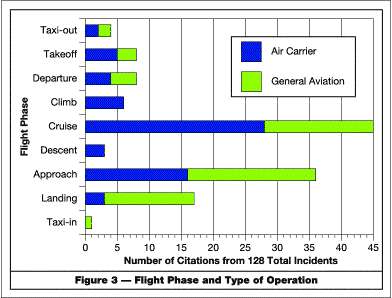|

|
Issue
Number 6 : August 1993
|

by Charles Drew,
Andrew Scott, and Robert Matchette
The key to any good relationship,
whether in marriage, at the office, or between pilot and controller is communication.
Pilots and air traffic controllers know that the safe and efficient movement
of air traffic requires good voice communication between air traffic control
facilities and aircraft, yet most pilots and controllers have experienced a
loss of communication at least one time or another, for a variety of reasons.
A Near Thing
The following event, reported to
ASRS by several participants, illustrates the problems that can arise when communication
is not possible. A Center facility had jurisdiction over two air carrier aircraft,
both at flight level 350 and on a nearly head-on converging course. The Captain
of air carrier X writes:
- "...We were given a routine
radio frequency change...We tried to check-in on the new frequency several
times, but were blocked by other transmissions. The Controller on this frequency
was extremely busy...While waiting for a break to check-in, my First Officer
called out traffic to me at the 2 o'clock position. The traffic, a wide body
[jet], was in my blind spot (behind a windscreen post). When I saw the aircraft
I watched for approximately 10 seconds and determined we were on a collision
course. I initiated an immediate descent out of 35,000 feet." (ACN 187551)
The First Officer of air carrier
X adds:
- "...I figure we missed by
800 feet vertical separation. He went directly over us. I'm sure we would
have collided had I not seen this aircraft." (ACN 187556)
And a Controller provides the conclusion:
- "This near-miss occurred
because air carrier Y didn't maintain a radio watch over the whole northern
hemisphere while on a...[trans-Atlantic] flight, and another aircraft was
not retrieved from a wrong frequency by a supervisor working radar-- because
of human error...Air carrier Y never saw air carrier X." (ACN 189213)
Several communications-related problems
occurred here, including the flight crew of air carrier Y not maintaining a
listening watch on frequency, and aircraft X being sent to the wrong frequency
by ATC--perhaps with insufficient time for a recovery. How many ways can you
lose your com (and your calm). Well...
There Must Be 50 Ways...
There must be at least fifty ways
to lose communication and here are just a few:
misset the aircraft audio panel
set the aircraft radio volume
too low
assign an incorrect frequency
to an aircraft
experience an electrical system
failure
forget to turn on the aircraft
alternator
have a "stuck mike"
tune the wrong frequency on the
aircraft radio
have an ATC facility radio failure
get frequency blockage due to
radio congestion
fall asleep
forget to switch to a new frequency
try to communicate on the wrong
radio.
Sound familiar? Perhaps you can think
of thirty-eight more. Given the potential hazards, a review of the causes and
effects of interruptions to communication sounds like a pretty good idea. An
initial investigation, using ASRS records, examined the causes and effects of
loss of communication events. A follow-up study looked at the principal human-factors
issues involved in delayed recognition of loss of communication
on the part of pilots who experienced this problem. Here are the six most interesting
findings of these two studies:
Causes for Communication Interruption
Misset Radios
As can be seen in Figure 1 below,
pilots' inadvertent missetting of aircraft radios or audio selectors accounted
for over half of all interruptions to communication. Notes a pilot:
- "We were experiencing loud
noise over the radio, and so we tried switching radios while getting the ATIS
at the destination airport...and in turn left Approach [Control] on the radio,
but on the wrong side (plane is equipped with flip/flop radios). After several
minutes of radio silence, we noticed what had happened and switched Approach
back on and called them. The Controller was upset and announced we had delayed
7 other aircraft due to our mistake." (ACN 189101)

Radio Problems
An aircraft radio problem or failure
was the next most commonly noted cause for loss of communication, but pilots
of general aviation (GA) aircraft (specifically light single-engine types) were
more likely to experience loss of communication through aircraft radio failure
than were operators of other aircraft types. The following report from a general
aviation pilot illustrates not only the potential problems with general aviation
aircraft electrical systems, but also a reasoned response by the reporter, and
the invaluable employment of a hand-held portable transceiver:
- "...In a single instant,
the electrical system failed. The off flags on the navigation receivers dropped,
all LCD [liquid crystal] displays disappeared, and there was no reply light
on the transponder. I attempted radio contact anyway, but there was no sidetone
in my headset so I doubted I was transmitting. I heard no other radio traffic.
I was IMC at the time and squawked 7700. I knew that the destination area
was VFR. However, I was transient and therefore unfamiliar with the area.
It took me a moment to realize that I carry a portable transceiver for this
very situation. I pulled it out, connected the headset, and attached it [the
radio] to the external antennae cable. Unfortunately, I could not monitor
the primary Center frequency. That information was locked in the memory of
the now inoperative radio panel. I had fallen into the trap of not manually
logging on paper the assigned frequency...I attempted contact on 121.5 but
got no response.
"I navigated as best as possible, and soon broke out into VMC. I headed
for the first airport I saw. Some quick dead-reckoning and the VFR chart I
had been using to monitor flight progress led me to believe, correctly, that
it was Scottsdale. I changed the hand-held frequency to Scottsdale Tower and
was able to make contact." And after a safe landing... "Maintenance
examined the aircraft the next day and determined that the [aircraft] battery
had shorted; at least one cell was dry." (ACN 156291)
Blocked Frequency
A "stuck mike" (in which
a microphone, radio transmitter, or audio selector panel failed in the transmit
mode) was known to be the cause in about 60 percent of blocked frequency incidents.
ATC facility transmitters and combined weather conditions/frequency overlap
each accounted for less than 10 percent of occurrences. The following report
is typical of stuck mike incidents:
- "Shortly after switching
to Washington's final Approach Controller, an aircraft began broadcasting
on the frequency with a stuck mike. The aircrew maintained a steady stream
of conversation not pertinent to their flying duties...effectively jamming
the frequency while we were awaiting further vectors for sequencing into Washington
National during the afternoon rush. Fortunately, the alert Controller managed
to announce an alternate frequency and regained control of the situation."
(ACN 173930)
And in another classic stuck mike
event:
- "...After three minutes of
radio silence I had begun to wonder if I had lost communications with the
Radar Controller. My instincts were right--we had lost radio contact...In
the cockpit I had a few choice words to say about my aircraft and radios which
should not have been said at any time."
And later, when asked to contact
the Facility Supervisor on the telephone:
- "He [the Supervisor] said
'Now how are your blank-blank radios doing?...We have everything on tape,
everything! We had to go to a backup frequency because of your language. You
apparently had a hot mike.' " (ACN 153914)
Duration of Lost Com
Figure 2 shows the average (mean)
duration of the loss of communication, which ranged from a low of 30 seconds
to a high of 1 hour. When various causes for loss of communication were combined,
the average duration was 7.6 minutes.

Phase of Flight
In what phase of flight are pilots
most likely to experience a loss of communication? The answer differs depending
on whether the operator is an air carrier or general aviation. (See Figure 3.)

Air Carrier = Cruise
According to the McDonnell Douglas
1992 Commercial Jet Transport Safety Statistics review, air carrier aircraft
spend an average of 64 percent of total flight time in cruise, thus it is not
surprising that air carrier pilots experience the majority of event occurrences
in the cruise phase, but we found that there may be additional factors. On long
distance routes, and while in cruise, it is generally accepted that air carrier
flight crews will experience lowered levels of attention due to reduced stimulation
from cockpit management duties, which may lead to a reduction in pilot monitoring
of radio traffic. From an air carrier pilot:
- "...either we missed a frequency
change call, or Center failed to pass us to the next sector. Although all
three flight crew members were eating, I am reluctant to believe we all missed
the repeated calls ATC states they made to us directly and through other aircraft...But,
through inattention or subconscious reliance on a call from Center to start
descent, we continued on at flight level 350. We were nearly at ATL [destination]
when we recognized the problem. After a rush to re-establish communication,
I made contact with ATL Center and reported overhead ATL at 35,000 feet..."
(ACN 188575)
GA = Approach and Landing
Combined approach and landing phases
provided the greatest number of events for pilots of light single and twin GA
aircraft. Why? Well, for one thing GA pilots, when all types of operations are
considered, probably spend less time in cruise than do air carrier flight crew.
For another, they usually have significantly less cockpit automation and often
a single-pilot operation, therefore a general aviation pilot may be required
to devote greater attention to positional and situational awareness while in
cruise, which may result in heightened levels of awareness. However, a general
aviation pilot on an instrument approach and landing usually has fewer and less
sophisticated system and navigational devices, less total and recent experience,
and less opportunity for task sharing when operating single-pilot. He or she
often has to cope with a higher individual workload than their airline counterpart,
and the opportunity for task overload is enhanced. Of course, sometimes a pilot
makes his or her own problems, as in the following report by a flight instructor:
- "While we were landing at
SJC in a light aircraft (X)...the Tower advised us of light aircraft Y making
a right cross-wind departure. I reported looking for him...then continued
looking for [other] reported traffic. No sighting. Many calls at the same
time to other aircraft by Tower. Turned off speaker switch to tell student
to descend to pattern altitude..."
And after the reporter had spent
some time in the now quiet environment...
- "What's wrong? No speaker!
Darn. Switch on! ...Tower called...'Where have you been? We've been calling
you for the last five minutes.' " (ACN 157097)
Low Experience = More Loss of Com
Events
There is a significantly increased
opportunity for lost com occurrences when one or more of the flight crew is
low time on the aircraft type--this is particularly true for general aviation
pilots. Figure 4 provides the frequency of lost communication events vs. time-in-type
for GA pilots. (A similar, but less pronounced pattern was revealed for air
carrier pilots.)

Times in Figure 4 are in 50 hour
segments from 1 hour to 50, 51 to 100, and so on. The "spike" noted
in the 251 to 300 hour segment is probably a result of "rounding"
by reporters. (A reporter with 276 hours, or 310 hours for example, may tend
to round his experience to 300 hours.)
Delay in Recognition
Preoccupation or distraction with
tasks in high workload situations was commonly noted in delayed recognition
of loss of communication. Note the following report:
- "Upon change over from approach
to tower frequency, new F/O failed to move COM selector head switch to new
frequency; we called on wrong frequency for landing and call was covered by
another aircraft transmission. I thought we had called on tower frequency
and were cleared to land, but we were distracted at this time by performing
the final landing checklist...." (ACN 182606)
At the opposite end of the causal spectrum, loss of awareness or lowered levels
of awareness was also a significant contributor to delayed recognition of com
loss:
- "While in cruise, the Captain,
acting as pilot-not-flying, was given a frequency change to Chicago Center,
I believe. I do not remember a reply to his call on frequency. Sometime thereafter
I noticed there was no one on frequency talking. I said it sure is quiet.
He said 'Yeah,' so I called Center for a radio check -- no reply. So I switched
back to previous frequency. Controller stated he had been trying to reach
us, gave us a new frequency. I feel it was due to fatigue that we had not
caught the apparent wrong selection of a new frequency ...." (ACN 189021)
Recognition of Com Loss
Most commonly, flight crew discover
their communication loss when they made a normal attempt to communicate with
ATC:
- "...Had a...mike switch which
stuck in the transmission mode. ATC said that had been that way for 15 miles.
I had not heard from ATC for some time and it was about time for a frequency
change. I attempted to call ATC and then discovered the sticking switch..."
(ACN 179290)
The next most common reason for communications
recovery was intervention by the controlling facility on another frequency,
or through company or ARINC channels as illustrated in the following report:
- "...Center read a clearance
so fast that neither my FO nor I had a chance to copy it, nor were we sure
if that clearance was for us. I called Center back and said that if that clearance
was for us, we did not copy it...I called again and still no response...About
5 minutes later an air carrier flight called us on 118.15 (our ATC frequency)
and advised us that Center wanted us to immediately climb to 31,000 and turn
to 180 degrees..." (ACN 156274)
Observations and Recommendations
Let's see if there may be some useful
recommendations for reducing the frequency, duration and severity in lost communication
events.
General Considerations
As noted, the most common reason
for a misset radio is inadvertent pilot mis-selection of a frequency. The best
solution to this problem is the old solution--proper attention to detail and
good cockpit management and monitoring on the part of the flight crew.
- Pilots should be aware that there
is a significantly increased opportunity for a lost communication event when
pilot experience in the aircraft type is low. Continued emphasis on the value
of situational awareness will help.
- Pilots often experienced difficulty
in returning to an original frequency if there was an error in selection or
clearance to a new frequency. A simple and effective aid for pilots is to
write down assigned frequencies; should a loss of communication occur at the
point of a frequency change, the pilot may easily return to the previous frequency.
- One reporter, as a final thought
in his misset frequency report, suggested that facility frequencies be reproduced
on enroute navigation charts. This could be either the primary sector
frequencies, or perhaps a "general" frequency shared by a number
of sectors within a facility through which a recovery could be effected.
- The seriousness of "stuck
mike" events could be significantly reduced by the use of transmitter
"time-out" devices that terminate transmission after a reasonable
time period.
- Military aircraft, in addition
to their normal radio package, are usually fitted with radios that receive
on "Guard" frequencies 121.5 and 243 MHz. The volume of these emergency
radios cannot be reduced, and in-coming transmissions on this radio will override
other communications. If all aircraft operating in the ATC system were fitted
with such radios, recovery of aircraft with misset radio and blocked frequency
problems could be effected more readily.
GA Pilots
- Loss of situational awareness
in high workload situations, and problems with aircraft radios or electrical
systems were commonly noted problems for GA pilots. Thorough pre-flight planning
can help reduce the impact in high workload situations. GA pilots should know
their electrical system, and should constantly monitor the electrical system
in flight and should consider terminating the flight at the first signs of
system problems.
- Where high cockpit workloads contribute
to loss of communication such as during Approach and Landing, adherence to
cockpit disciplines (such as the sterile cockpit), and maintenance of positional
awareness should serve to reduce delays in event recognition.
- A number of ASRS reports from
general aviation operators note the use of hand-held portable aviation radio
transceivers--as backup to aircraft mounted radio equipment. In four incidents
the "hand-held" can be credited with a communications "save,"
and there are additional reports among those reviewed for this study that
cite effective use of these portable communications radios.
Transport Pilots
- Review of pertinent records indicates
that pilot recognition of interrupted communication in the Cruise phase, (notable
for a low workload environment and a point where ATC communication and chatter
are minimal), may be facilitated by the motherhood and apple pie solution
of constant situational and positional awareness.
- For high altitude flight, noting
the location of ARTCC Facility boundaries as marked on charts should serve
to alert pilots to required hand-offs.
Controllers
- Controller intervention through
use of company or ARINC frequencies is effective when used.
- Those incidents wherein an ATC
facility used an alternate communications process to "recover" an
interrupted-communication aircraft showed good success. Use by facilities
of alternate communications procedures such as company frequency, aircraft
relays, SELCAL, ARINC, and ACARS tends to be effective.
- It is suggested that ATC facilities
review alternate communications possibilities in the event of frequency blockages,
including periodic resting of the battery-operated Gonset radios.
| Reproduction
and redistribution of ASRS Directline articles is not only permitted--it
is encouraged. We ask that you give attibution to ASRS Directline, to the
Aviation Safety Reporting System (ASRS), and of course, to the authors of
each article. |
![]()





